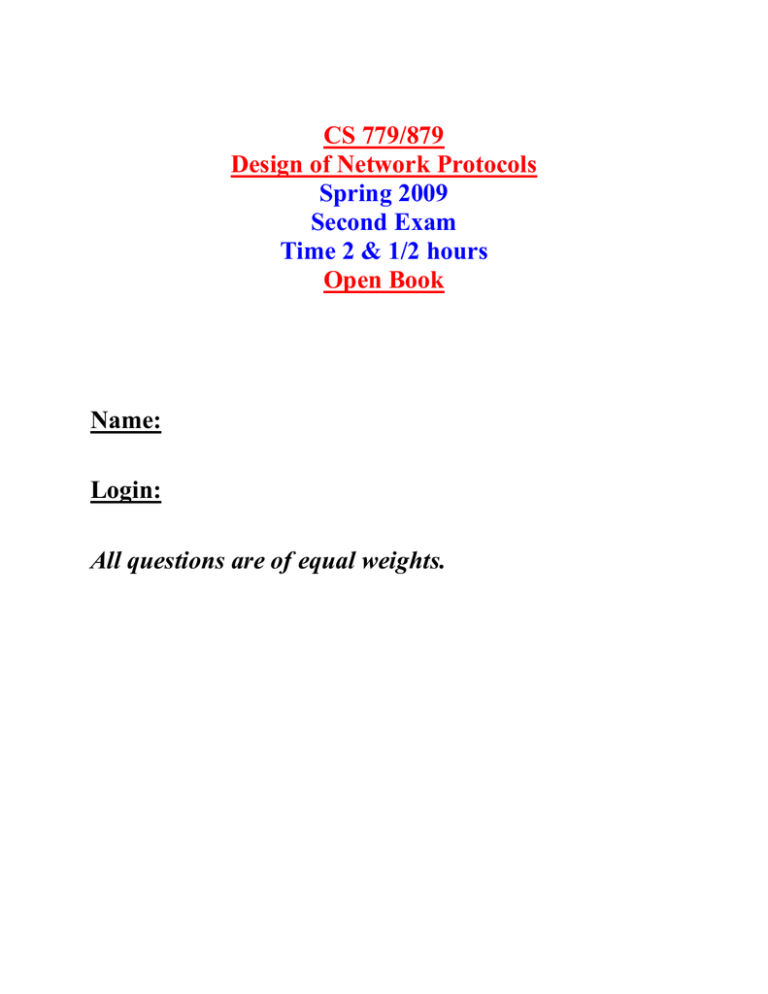CS 779/879 Design of Network Protocols Open Book
advertisement

CS 779/879
Design of Network Protocols
Spring 2009
Second Exam
Time 2 & 1/2 hours
Open Book
Name:
Login:
All questions are of equal weights.
Question 1:
The following functions can be used to read from or write to a socket S:
read
recv
recvfrom
recvmsg
write
send
sendto
sendmsg
Specify which of the preceding functions can be used with S if the type of S is:
T:
TCP
U:
UDP
Uc: Connected UDP
S:
SCTP S
Q:
SCTP Q
Qc: Connected SCTP Q
You may answer this question by entering Yes or No in the following table:
T
read
recv
recvfrom
recvmsg
write
send
sendto
sendmsg
U
Uc
S
Q
Qc
Question 2:
Consider the following set of SCTP Daytime Servers and Clients:
S4S: Server IPv4 Stream: DayTimeServer4SctpS
S6S: Server IPv6 Stream: DayTimeServer6SctpS
C4S: Client IPv4 Stream: DayTimeClient4SctpS
C6S: Client IPv6 Stream: DayTimeClient6SctpS
S4Q: Server IPv4 Sequence Packet: DayTimeServer4SctpQ
S6Q: Server IPv6 Sequence Packet: DayTimeServer6SctpQ
C4Q: Client IPv4 Sequence Packet: DayTimeClient4SctpQ
C6Q: Client IPv6 Sequence Packet: DayTimeClient6SctpQ
Each client has to specify the IP address of the server. The IP address of the server may be
specified using one or more of the following 3 format:
4: IPv4 address format, e.g., IPv4: 128.82.4.210 or
6: IPv6 address format: fe80::203:baff:fe2a:67ff or
m: IPv4-mapped IPv6 address, e.g., ::ffff:128.82.4.210
Use the above symbols (4, 6 or m) to fill in each entry in the following Table with ALL
possible correct address formats
that can be used by a client to interact with its corresponding server:
C4S
S4S
S6S
S4Q
S6Q
C6S
C4Q
C6Q
Question 3:
The following udp client that sends a question to a udp server and then display the
returned answer:
main(int argc, char **argv)
{
int sendsock;
struct sockaddr_in dest;
struct sockaddr_in cliaddr;
int len;
char Answer[1024];
char *Question;
sendsock = socket(PF_INET,SOCK_DGRAM, 0);
dest.sin_family = AF_INET;
dest.sin_addr.s_addr = inet_addr(argv[1]);
dest.sin_port = htons(atoi(argv[2]));
Question = argv[3];
sendto(sendsock, Question, strlen(Question), 0, (SA*)&dest, sizeof(dest));
len = sizeof(cliaddr);
recvfrom (sendsock, Answer, sizeof(Answer), 0, (SA *) &cliaddr, &len);
printf("%s\n", Answer);
}
Note that if there is no server running at the specified host and port then the client hangs
forever.
To solve this problem we may:
1. Use the concept of connected client.
2. Use the select or poll
3. Use the Alarm signal.
Modify this program to use any one of these three techniques.
Question 4:
Explain how it is possible to write a server that uses one port and can handle the requests
from any client that uses any of the following transport protocol types:
tcp, udp, sctp
and any IP protocol type:
ipv4, ipv6
Question 5:
Describe how an sctp program can:
1. Send a message on a specific stream?
2. Determine which stream a message is received?




